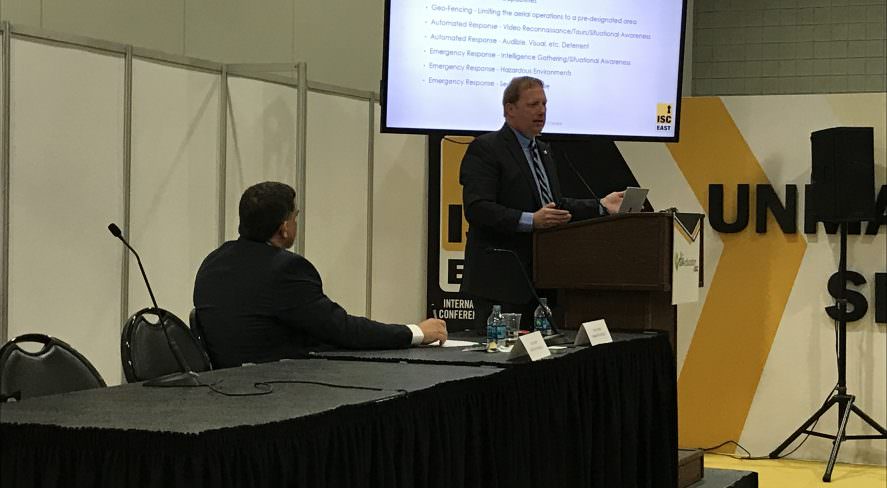Exploring Drones as Threat or Asset at ISC East

In January 2015, a federal employee unintentionally crashed a small drone onto the White House lawn in the late hours of the night.
The employee, a scientist with the National Geospatial Intelligence Agency, avoided charges for the regrettable accident, in which no one was hurt, but the incident shined a light onto the dangers of a drone attacking or dropping a payload into a restricted area like the high-profile White House.
Mark Schreiber, Principal Consultant, Safeguards Consulting LLC, recalled the incident during a presentation at ISC East in New York City on Wednesday, citing means by which drones can pose a security threat or become a security asset.
An adversary can use a drone for surveillance against a target said Schreiber. Drones can use video, terrain imaging or LIDAR to map vulnerable territory.
Drones also can threaten immediately through dropping explosives or transforming into a flying gun aimed at a target.
In both cases, specific exhibitors at ISC East offer drone countermeasures of value to security managers, Schreiber said. Some manufacturers deploy compact radar to detect drones. Attendees at ISC East can visit DeTect Inc. in Booth 360, Gryphon Sensors in Booth 364, and SpotterRF in Booth 259 for examples of the technology.
Some manufacturers produce sensors that can detect drones through radio frequency (RF) detection, Schreiber noted, referring conferees to Dedrone in Booth 262 and Gryphon Sensors in Booth 364.
An alternative is RF monitoring and interruption, which can disrupt a drone. However, such approaches currently violate Federal Communications Commission and Federal Aviation Administration (FAA) rules, Schreiber cautioned.
Dedrone in Booth 262 also provides the option of acoustic sensors for detection of drones. Crowdsourcing through a smartphone application such as that produced by Drone Watch in Booth 360 is also an option for tracking drones, Schreiber said. Also, some companies make large area radar, which can detect drones. Security personnel also can manually intervene against drones with a directional jammer.
Finally, a netting projectile can capture a drone, such as the case with the system made by Airspace Systems in Booth 3145, Schreiber said.
Of course, security operators can deploy drones to benefit their security operations. A popular option is to use drones for video surveillance, assessing areas inaccessible by some people on the ground. In some cases, drones also can provide an automated response against a threat. Drone company Nightingale Security provide such services.
Overall, unmanned aerial systems may offer geofencing, automated response or emergency response capabilities, Schreiber said.
The small drone market, for systems at 55 pounds or less in weight, is estimated at $2 billion currently, and PwC projects it will reach $127 billion by 2020, said Jason Cansler, Chief of Operations, Under the Sun Imaging LLC.
That growth will create 70,000 new jobs by 2020 in an average growth rate of 51 percent a year, he estimated. Currently, there are 2.5 million active drones in the United States with more than 60,000 commercial operators qualified to fly them.
FAA has registered more than 900,000 drones as of September 2017. In contrast, manned aircraft registrations only have reached about 320,000 after roughly a century.
“The industry is really booming, and the market is learning what they can do,” said Cansler.
Schreiber and Cansler made their presentation as a session for SIA Education@ISC East. For more information on the conference program, underway at the Javits Center in New York on Nov. 15-16, visit www.isceast.com/Education.
